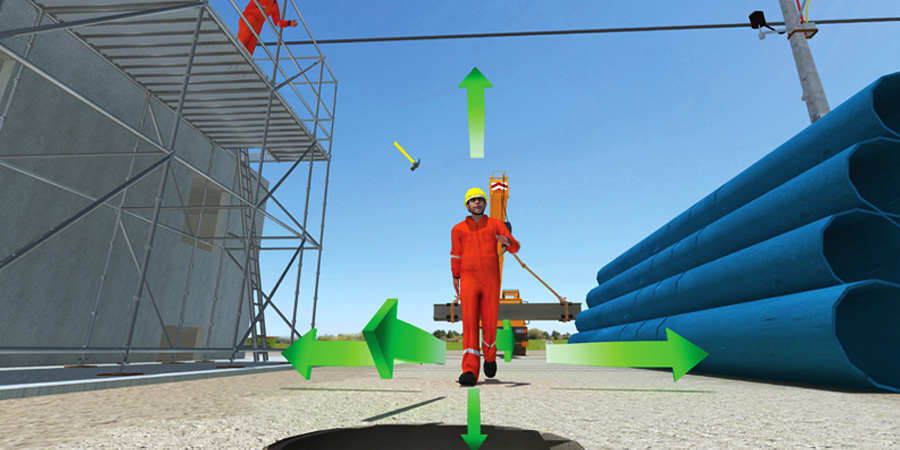Six directional hazard identification and analysis – A brief study

Every Manufacturing organization or Construction company believes that there is no task which is more important than workmen’s health and safety. In case of any job that represents a potential safety or health threat, every effort should be made to plan a better way to complete the task in a safer manner. Every procedure must be a safe procedure. Shortcuts in safe procedures by management and all the other associates should not be tolerated. If a worker observes any unsafe or unprotected exposure, which may pose a potential threat to their safety and health, he or she must inform the management immediately.
Hazard Identification: An Essential Component of Workplace Safety
Hazard identification is a crucial aspect of ensuring workplace safety, as it allows employers and workers to identify potential hazards and take steps to mitigate or eliminate them. By conducting regular hazard identification assessments, organizations can proactively identify and address potential hazards before they result in accidents or injuries.
At any workplace there are physical, chemical, biological, psychosocial, electrical, mechanical and traffic hazards. Then there are common hazards in terms of falls from heights, falls into a depth, slips, trips and falls; manual handling and exposure to hazardous substances. In addition to these, there are identifiable hazards like a body part striking against, being struck by, making harmful contact with an object, caught in, on, by or between objects, slip, trip or fall, abrasion from any object, reaction to any chemicals, strains from pushing, pulling, lifting, bending or twisting etc.
At every workplace it is required to spot hazards in all six directions like east, west, north, south, top and bottom area.
One effective method for conducting hazard identification is the six directional hazard identification approach. This approach involves identifying hazards from six different perspectives: from the front, from the back, from the left, from the right, from above, and from below. By considering potential hazards from all of these directions, organizations can gain a comprehensive understanding of the hazards present in their workplace and take appropriate measures to address them.
Six Directional Hazard Identification Process is designed keeping the followings things in mind:
- What task are you about to perform?
- What tools and equipment will be used during the process?
- What mitigation or elimination steps will be taken into consideration to resolve each hazard as the task is executed?
Basically, 6 directional hazards identification is a process to identify associated hazards of unsuitable or faulty materials, inadequately supported scaffold, any loose items, any kind of obstacles, liquid spills, release of hazardous liquid or gas from pipe lines, leakages from the defective components, inadequate or irregular platform area, omission of hand rails, toe boards, failure to secure loose components, faulty alterations without approval, unsecured ladder slip, misuse of tools and tackles, overloading of platforms, unsecured ladder slip, fire due to welding / gas cutting activities, falling object, falling of person, protruding nail or sharp edge of any structure, being hit by exposed parts of structures, overhead electric lines etc.
Implementation and monitoring of safety management system ensures that all workmen are alert at workplace, watching out for hazards and report them to concerned supervisor. Six directional hazards identification process is used to fix hazards and make the workplace safe. Spotting the hazard in terms of unsafe condition or unsafe act in either construction or operation / maintenance activities is a process of identifying and accessing the RISK in the system.
A system of identifying six directional hazards and its analysis intends to provide safe working positions at workplace area. This system eliminates fall exposures, fall-arrest equipment, and the use of barrels, boxes, loose tile blocks or other unsuitable objects as means to support work-on platforms. As part of any execution work at the time of receipt of the work permit, prior to its start and as a part of safe work preparations, six-directional hazard identification is being carried out.
Method of Six Directional Hazard Identification and Analysis includes:
- Job safety management planning tool
- Planning safe execution of work
- Improving work efficiency and effectiveness
- Provision of information communication
- An accident prevention tool
- Identification of inherent hazards associated with a specific task or group of tasks
- Eliminating or mitigating hazards
- Stipulating controls, precautions and safe-guards
- Defining potential hazards
- Creating a plan – ‘Safe System of Work’
- Minimizing risks the workforce will actually face
- Coordinating and controlling potential high risk activities
- Communication of hazards and controls – to the people actually doing the work
- Avoiding injuries and or damage, interruptions to process/operation
How Safety Management Software Can Help You Identify and Mitigate Workplace Hazards
When it comes to recognizing risks in the workplace, the six directional danger identification method is pretty effective. However, this technique may be time-consuming and require quite a few attempt. Thankfully, there is a solution – safety control software. By automating the danger identity manner, this software program makes it less difficult and faster to discover potential risks. Ultimately, it improves place of business protection through reducing the chance of accidents and injuries.
Our first-rate safety management software program employs the six directional hazard identification approach to pinpoint any capability hazards in your place of business. What units our software aside is that it now not simplest identifies those hazards however also generates a complete document detailing each threat and its related dangers. This file is an invaluable resource for developing strategies to mitigate these dangers efficiently.
Incorporating our modern-day safety control software into your operations can make a massive distinction in phrases of place of job safety. It is going past simply identifying risks; it facilitates you evaluate dangers and broaden tailor-made plans to minimize the ones dangers thus. This proactive technique plays a critical function in coincidence prevention and creating an average more secure environment for all of us worried.”
In Conclusion
Using the six directional hazard identification approach can help organizations to create a safer work environment for their employees, reduce the risk of accidents and injuries, and improve overall productivity. By making hazard identification a priority and using effective methods like the six directional hazard identification approach, employers can ensure that their workplaces remain safe and healthy for everyone.



Thanks for sharing it.
Good information
Nice
Hazard identification is equally important to preventing such accidents.